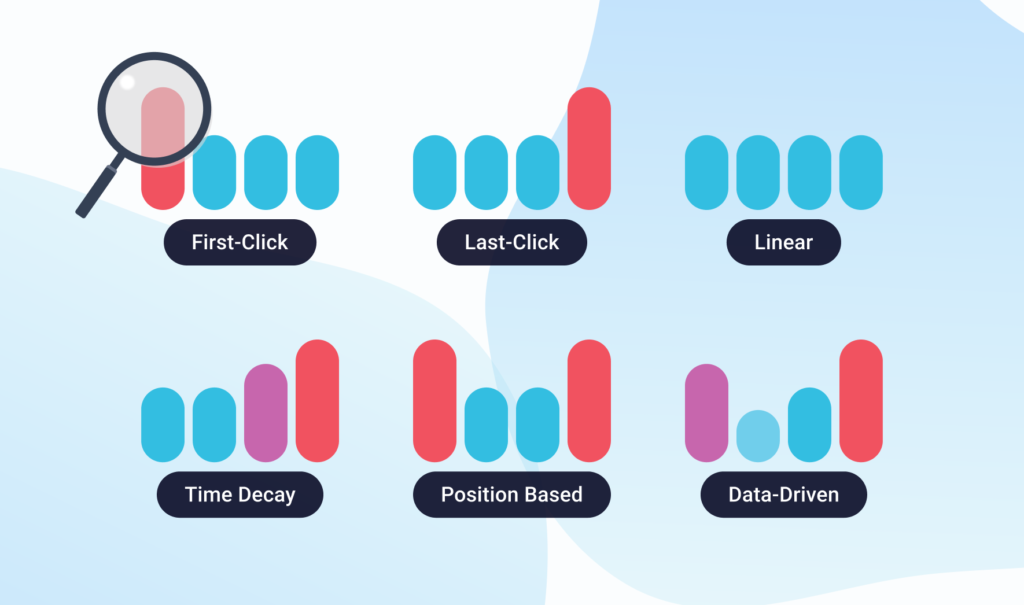Attribution modeling is the process of analyzing and understanding how different marketing channels and tactics contribute to conversions and revenue. It helps businesses understand the customer journey and how different touchpoints along the way influence the final conversion. Attribution modeling can help businesses understand which channels and tactics are most effective and where to allocate budget for optimal ROI.
There are different types of attribution models businesses can use, each with its own method of assigning credit to different touchpoints in the customer journey. Some of the most common attribution models include:
Last-click attribution:
This model assigns 100% of the credit for a conversion to the last touchpoint before the conversion. For example, if a customer clicks on a Google Ad and then converts on the website, the Google Ad will get 100% of the credit for the conversion.
First-click attribution:
This model assigns 100% of the credit for a conversion to the first touchpoint. For example, if a customer clicks on a Google Ad, then reads an email and then converts on the website, the Google Ad will get 100% of the credit for the conversion.
Linear attribution:
This model assigns equal credit to all touchpoints in the customer journey. For example, if a customer clicks on a Google Ad, reads an email, and then converts on the website, the Google Ad, email and website will each get 33% of the credit for the conversion.
Time decay attribution:
This model assigns more credit to touchpoints closer in time to the conversion. For example, if a customer clicks on a Google Ad, reads an email, and then converts on the website, the website will get more credit than the email, which will get more credit than the Google Ad.
Custom attribution:
This model allows businesses to assign custom credit to different touchpoints based on their own criteria.
Attribution modeling can be done manually or with the help of software and tools that provide businesses with the ability to track and analyze customer behavior, and attribute conversions to specific marketing channels.
Attribution modeling is an important aspect of tracking the impact of marketing efforts, it helps businesses understand the customer journey, and how different touchpoints along the way influence the final conversion. By using the right attribution model, businesses can make more informed decisions, optimize their strategies, and allocate budget more effectively to achieve better ROI.
Algorithmic multitouch revenue attribution is a method of using advanced algorithms to assign credit to different touchpoints in the customer journey. This method goes beyond traditional attribution models, which often rely on a set of predefined rules to assign credit. Algorithmic multitouch revenue attribution uses machine learning and other advanced techniques to analyze customer behavior and determine the true impact of each touchpoint on the conversion.
There are several methods and models that can be used for algorithmic multitouch revenue attribution:
Markov Chain Model:
This model uses a mathematical algorithm to analyze customer behavior and determine the likelihood of conversion based on each touchpoint.
Shapley Value:
This model is based on game theory and assigns credit to touchpoints based on their marginal contribution to the conversion.
Heuristic Algorithms::
This method uses a set of predefined rules to assign credit to touchpoints based on their relationship to the conversion.
Machine Learning:
This method uses machine learning algorithms to analyze customer behavior and determine the impact of each touchpoint on the conversion.
Bayesian Inference:
This method uses Bayesian statistics to analyze customer behavior and determine the impact of each touchpoint on the conversion.
Random Forest:
This method uses an ensemble of decision trees to predict the probability of conversion based on customer behavior.
Each of these methods and models has its own advantages and disadvantages, and the choice of method will depend on the business’s specific needs and goals.
Algorithmic multitouch revenue attribution can be used to gain a deeper understanding of the customer journey and the impact of different touchpoints on the conversion. It can help businesses identify which channels and tactics are most effective and where to allocate budget for optimal ROI. Additionally, it can be used to optimize marketing strategies and improve the customer experience. However, it’s important to note that algorithmic multitouch revenue attribution can be complex and may require the use of specialized software or experienced data analysts.





